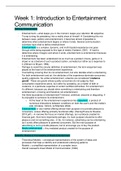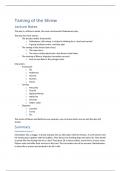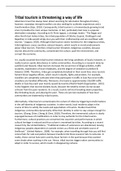Communication
Defining Entertainment
- Entertainment = what keeps you in the moment, keeps your attention ➔ subjective
- Trump turning his presidency into a reality show of himself → Considering this mix
between news, politics and entertainment, it becomes almost impossible to
determine when entertainment begins or where it ends. Several communication
scientists have tried to define entertainment
- Entertainment is a complex, dynamic, and multi-faceted experience one goes
through while being exposed to this type of media (Vorderer, 2001). → hard to
determine where it begins and where it ends, entertainment is entertainment because
it is entertaining
- Entertainment has been understood not so much as a product (movie, game or tv
show) or as a feature of such a product (action, comedy) but rather as a response to
it (Zillmann & Bryant, 1994).
- Perhaps to avoid this circular definition of entertainment, the term enjoyment was
placed at the heart of the entertainment experience.
- If something is boring then its not entertainment, but who decides what is entertaining
- For both entertainment and art, the attributes of the experience dominate consumers
quality judgments. So unlike entertainment, artworks are considered 'credence
goods'. These are goods whose quality consumers do not judge by their
consumption experience alone, but rather by accepting, as a matter of faith or
credence, in a particular expertise of certain certified authorities. For entertainment
it's different, because you decide when something is entertaining and therefore
entertainment, or boring and therefore not entertainment.
- Are there boundaries of entertainment? Immoral, unethical, obscene or disgusting. If
its enjoyable to someone its entertainment.
o At the heart of the entertainment experience lies enjoyment, a product of
numerous interactions between conditions on both the user’s and the media’s
side (Vorderer, Klimmt, & Ritterfeld, 2004).
- Entertainment is ‘any market offering whose main purpose is to provide pleasure to
consumers, versus offering primarily functional utility’ (HennigThurau & Houston,
2019 p41). → narrows the focus on market offerings, as in products created for
financial gain. And more importantly perhaps, it's main purpose should be to offer
pleasure and not something else. → So, for instance, advertising can be entertaining
as it surely offers pleasure to potential consumers. But the main purpose of
advertising is not to provide pleasure, but to encourage you to buy the product.
- Media entertainment = Any mediated product created for the purpose of
entertainment
Scientific Models & Frameworks of Media Entertainment
- Theoretical Models = conceptual representations of the system of ideas and
processes that help us identify and understand underlying patterns.
- Models = a simplified representation of a complex issue.
- Harold Lasswell’s linear Model of Communication (1948)
, o
o Basics of mass communication → your speaker says something through a
certain medium to someone with a certain effect.
o not a causal model → it is a process model explaining how messages through
the media can affect specific audiences. And it's linear because it's process
goes only in one direction.
o But this model is outdated because people choose entertainment products
that fit their needs → Uses & Gratifications → which is why we add the arrows
to the model
o How? Is added to, but now its too complex
- DSMM (2013)
o
o places the audience first. And the audience disposition, their developmental
level, social contexts. They influence their choice for certain media. And they
also moderate its effects on the user.
o Included step between media use & effect = response → These responses
dictate continuous and repeated entertainment use, because if something is
emotionally impactful, interesting and exciting, you usually want to experience
it more and more.
- The Complexity of the entertainment Experience (2004)
, o Places enjoyment at the heart of the entertainment experience, however,
enjoyment is not the only outcome of entertainment
o Manifestations → response states
o Circular process → self-perpetuating cycle
- These 3 models form the basis for ‘the media entertainment model’.
o
o rectangular boxes are more or less objective and measurable concepts, and
the arrows are mostly theoretical processes.
o Entertainment products (green) have 2 concepts = label & design
o Users = preference & response
o Circular process model = somewhere in your early infancy you start using and
experiencing media and entertainment, likely at first selected by your parents,
and over time, your knowledge, your attitudes, your beliefs about
entertainment are formed. Your preference for entertainment at a certain point
determines to a large degree which entertainment media are selected, and
we take media here in the broadest sense.
o Label = before you experience entertainment, you first select it. You select it
based on its identifiable characteristics such as the medium, the title, the
genre, the brand.
o Design = Each entertainment product can have all sorts of design elements:
narrative design, cinematography, game design, composition etcetera →
provide users with experience
o Respond is not the same as effect.
Preferences of the Users in the selection of entertainment in the Media Entertainment Model
Summary: preferences, motivations, social influences, habitual & problematic selection
theories
- = your preference for entertainment determines which entertainment products are
selected. This entertainment product can have all sorts of design elements that
provide users with the experience and your response to this experience will then
affect your preference for this or similar types of entertainment
- Users = we are unique, but we are part of a group. 4 identifiers:
, o Demographics (gender, age, education, ethnicity) = strong predictors for
specific entertainment
o Social Characteristics (family, peers, society, culture) = members influence
each other
o Trait and State (personal aspects, mood, values, beliefs, cognitive
capabilities, personality) = temporal things that may influence your state at a
certain moment
o Experience with media entertainment (experience, knowledge) = shape our
emotional, cognitive, and physiological responses, which then combined with
our demographics, emotional state, personality traits or social contexts, they
all lead to shape our preference.
- The most prevalent set of preferences within a society is what we call Popular
Culture.
o The core of any culture is a set of attitudes, values, and beliefs that is shared
by a group of people. Culture provides members of the group the norms for
their behaviour (Deshpande & Webster, 1989).
▪ Group culture provide you the norms and attitudes for their behaviour.
o Popular culture (or pop culture) is the domain of entertainment products
created in mass quantities for a mass audience. It is generally recognized as
a constantly evolving set of practices, beliefs, and values that are dominant
or ubiquitous in a society at a given point in time
▪ Pop culture reflects our entertainment culture
▪ Popular culture products are generally recognized by everyone, and
they are extremely influential, not just economically, but culturally and
on a global scale
- Although pop culture reflects general cultural trends toward entertainment, there
remain vast cultural differences. → Cultural Congruence
o A nation transmits the values of what is to be appreciated (and what is not) to
its members, as part of a continuous and often lifelong socialization process.
o Consumers’ entertainment choices show their personal values, ambitions
beliefs, and perceptions of the world and themselves (Schäfer & Sedlmeier,
2009). → therefore what is appreciated in some cultures may not be
appreciated in others.
o The cultural congruence between an entertainment product and the
audience influences how much our consumers will select and like the product.
▪ E.g. Rocketman had an R-rating in America, because of drugs and
homosexuality, but in the EU had a U rating.
- Temporal Aspect of cultural influence → Zeitgeist
o = the defining mood of a particular period in history, as shown by the ideas
and beliefs of that time.
o Cultural trends can make consumers “ripe” for a product. The fit of any
entertainment product’s genres and themes with people’s interests and
desires may be high or low during certain periods.
o History provides examples that entertainment can become an embodiment of
a certain cultural zeitgeist, capturing and reflecting the life style of a certain
period.
o Entertainment products are more attractive in bleaker economic times,
despite consumers having less money at their disposal.
o Cancel Culture → what we consider inappropriate is deemed inappropriate
for anyone, and that can be products that were very popular a few years ago











